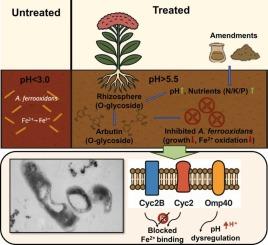Pioneer phytoremediation of highly acidic mineral soil: O-glycoside components of rhizosphere exudates inhibit Acidithiobacillus ferrooxidans
IF 11.3
1区 环境科学与生态学
Q1 ENGINEERING, ENVIRONMENTAL
引用次数: 0
Abstract
Acid mine drainage (AMD) remains a critical environmental challenge worldwide, primarily driven by acidophilic microorganisms such as Acidithiobacillus ferrooxidans. Traditional remediation methods, including lime neutralization and topsoil covering, often have limited effectiveness. A 180-day incubation trial using highly acidic mineral soil and a subsequent 90-day plant cultivation experiment was conducted to investigate the inhibitory mechanisms of key root-secreted compounds against A. ferrooxidans. The results demonstrated that the compost–biogas slurry amendment significantly elevated soil pH, nutrient availability, and enzymatic activities in the highly acidic mineral soil. The introduction of Hylotelephium erythrostictum (Miq.) H. Ohba further improved soil physicochemical properties, leading to a marked reduction in acid-producing bacteria, particularly members of A. ferrooxidans, while concurrently promoting beneficial microbial communities. Moreover, the amendment enhanced the release of rhizosphere exudates, notably O-glycosides and terpenoids. Among them, arbutin—an O-glycoside compound—was identified through pure culture assays and microscopic observations as a potent inhibitor of A. ferrooxidans. Arbutin suppressed bacterial growth and Fe²⁺ oxidation activity and disrupted cellular integrity. Molecular dynamics simulations revealed that arbutin binds to critical membrane-associated proteins of A. ferrooxidans (Cyc2B, Cyc2, and Omp40), resulting in significant reductions in α-helical content and destabilization of hydrophobic domains, thereby impairing catalytic functionality. These findings highlight O-glycosides as key antimicrobial constituents within the polyphenolic exudates of Hylotelephium erythrostictum (Miq.) H. Ohba. Overall, the combined use of compost–biogas slurry amendment and pioneer plant cultivation present an effective and sustainable strategy for the remediation of highly acidic mine soils, offering valuable insights for future ecological management of AMD-affected sites.

高酸性矿物土壤的先驱植物修复:根际渗出物的o -糖苷成分抑制氧化亚铁硫杆菌
酸性矿井排水(AMD)仍然是世界范围内一个严峻的环境挑战,主要是由嗜酸微生物如氧化亚铁硫杆菌驱动的。传统的修复方法,包括石灰中和和表土覆盖,通常效果有限。在高酸性矿质土壤中进行了180天的培养试验,随后进行了90天的植物栽培试验,以研究关键根分泌化合物对氧化亚铁铁杆菌的抑制机制。结果表明,堆肥-沼液处理显著提高了高酸性矿质土壤的pH值、养分有效性和酶活性。红血球菌(Miq.)的引入H. Ohba进一步改善了土壤的理化性质,导致产酸细菌,特别是氧化亚铁杆菌的显著减少,同时促进了有益的微生物群落。此外,该改良剂促进了根际渗出物的释放,特别是o -糖苷和萜类化合物的释放。其中,熊果苷(一种o -糖苷类化合物)通过纯培养和显微镜观察被鉴定为a . ferrooxidans的有效抑制剂。熊果苷抑制细菌生长和Fe 2 +氧化活性,破坏细胞完整性。分子动力学模拟表明,熊果苷与氧化亚铁的关键膜相关蛋白(Cyc2B、Cyc2和Omp40)结合,导致α-螺旋含量显著降低,疏水结构域不稳定,从而损害催化功能。这些发现强调了o -糖苷是红血球菌(Miq)多酚渗出物中关键的抗菌成分。大庭。综上所述,堆肥-沼液改良与先锋植物栽培相结合是一种有效且可持续的高酸性矿山土壤修复策略,为未来amd影响场地的生态管理提供了有价值的见解。
本文章由计算机程序翻译,如有差异,请以英文原文为准。
求助全文
约1分钟内获得全文
求助全文
来源期刊

Journal of Hazardous Materials
工程技术-工程:环境
CiteScore
25.40
自引率
5.90%
发文量
3059
审稿时长
58 days
期刊介绍:
The Journal of Hazardous Materials serves as a global platform for promoting cutting-edge research in the field of Environmental Science and Engineering. Our publication features a wide range of articles, including full-length research papers, review articles, and perspectives, with the aim of enhancing our understanding of the dangers and risks associated with various materials concerning public health and the environment. It is important to note that the term "environmental contaminants" refers specifically to substances that pose hazardous effects through contamination, while excluding those that do not have such impacts on the environment or human health. Moreover, we emphasize the distinction between wastes and hazardous materials in order to provide further clarity on the scope of the journal. We have a keen interest in exploring specific compounds and microbial agents that have adverse effects on the environment.
 求助内容:
求助内容: 应助结果提醒方式:
应助结果提醒方式:


